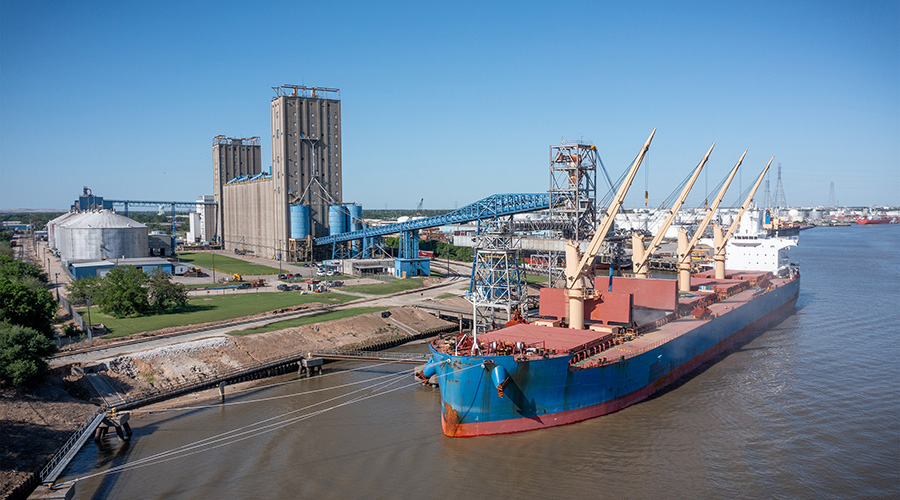Rail plays key role in Port of Brownsville's success
6/10/2021
By Michael Popke
The Port of Brownsville — located at the southernmost tip of Texas, adjacent to the U.S. border with Matamoros, Mexico — is coming off a record-setting 2020. Despite a global pandemic that led to economic challenges throughout the world, the port moved 11.2 million short tons of diverse cargo, generating operating revenue of $41 million. The port’s previous highwater mark for revenue was set in 2019 at $25.4 million.
The port also set a record for rail-car movements in 2020 at 51,115, a 24% percent increase compared with 41,207 in 2019.
“Rail has played a big role in the success of the port, not only with cross-border trade but connectivity to other parts of the country,” says Eduardo Campirano, director and chief executive officer of the Port of Brownsville. “And we’re running, for the first quarter of this year, about 27 percent ahead of last year’s [rail] totals for the same period.”
 “We had a great year last year, and year to date we’re at the same pace and see some continued growth opportunities with Mexico — especially in our traditional movement of commodities,” says Eduardo Campirano, director and chief executive officer of the Port of Brownsville. Courtesy of the Port of Brownsville
“We had a great year last year, and year to date we’re at the same pace and see some continued growth opportunities with Mexico — especially in our traditional movement of commodities,” says Eduardo Campirano, director and chief executive officer of the Port of Brownsville. Courtesy of the Port of BrownsvilleThree Class Is serve the port. Kansas City Southern de Mexico operates south of the border, with Union Pacific Railroad and BNSF Railway Co. handling the northern routes. KCSM also serves as UP’s intermediate switch to and from Mexico. Among the commodities transported by rail are steel slabs and coils, as the Port of Brownsville ranks among the top U.S. steel ports and moves more steel into Mexico than any other U.S. port, according to port officials.
The port’s largest steel customer — and Latin America’s biggest steel producer — is Monterrey’s Ternium Pesqueria (owned by Luxembourg-based Ternium S.A.). The mill is undergoing a multi-billion-dollar expansion that will result in greater steel production and more slabs moving through the port via rail, Campirano says.
Additionally, OmniTRAX Inc.'s Brownsville & Rio Grande International Railroad (BRG) provides service to all businesses at the port via more than 45 miles of port-owned track. BRG connects to UP, BNSF and KCSM.
In 2014, the port signed a strategic partnership with OmniTRAX to operate BRG and develop the GEOTRAC Industrial Hub, an industrial park with about 1,400 acres dedicated to light and heavy manufacturing, logistics, energy services, technology development and export/import warehousing. The port is home to about 270 tenants, Campirano says.
Other commodities passing through the port include grain, refined petroleum products and wind energy components. Twenty-one wind energy projects contributed to the port’s record-setting 2020, including the largest windmill blades (250 feet long) ever imported to the United States. Many of those blades wound up on rail cars for transport, Campirano says.
 The port set a record for rail-car movements in 2020 at 51,115, a 24% percent increase compared with 41,207 in 2019. Courtesy of the Port of Brownsville
The port set a record for rail-car movements in 2020 at 51,115, a 24% percent increase compared with 41,207 in 2019. Courtesy of the Port of Brownsville“We had a great year last year, and year to date we’re at the same pace and see some continued growth opportunities with Mexico — especially in our traditional movement of commodities,” he says.
Even though the 44,000-acre Port of Brownsville is the only deep-water seaport located directly on the U.S.-Mexico border, Campirano did not anticipate seeing such a high volume of wind-related products last year. That type of traffic is expected to be lighter this year, but rail will continue to be integral to the port’s intermodal connectivity.
“Railroads are our partners, and we see opportunities to expand that relationship — whether it’s with steel or other commodities,” Campirano says. “Hopefully, we can do more agricultural products and cross-border trade, not just going south but also coming north. Railroading is a big part of what we do.”
Michael Popke is a Madison, Wisconsin-based freelance writer.

